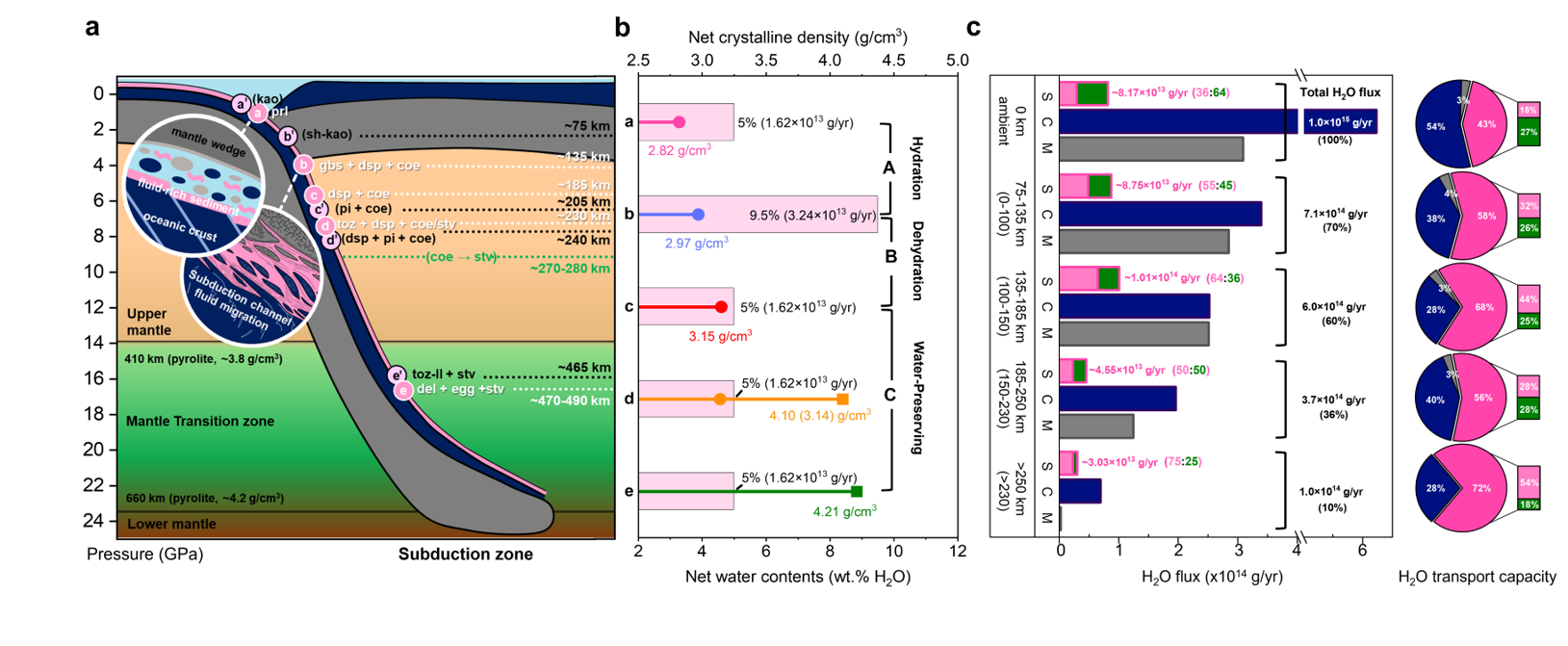Subduction zone is the main channel for delivering the surface volatile components to the deep Earth. Subducting sedimentary layer usually contains water and hydrated clay minerals. Under such hydrous subducting environment, the stability of clay minerals would constraint the lithology and physical properties of the subducting slab interface, and thus affect the geodynamic activities. New study from a team of scientists led by Prof. Yongjae Lee from Yonsei University collaborated with computational group led by Dr. Duck Young Kim from HPSTAR shows that pyrophllite (Al2Si4O10(OH)2), a representative clay mineral in the oceanic sediments, undergoes a series of continuous decomposition, high-pressure phase transitions along the water-saturated cold subduction zone down to~600 km depth in the Earth and transport ~5.0 wt.% of its own crystalline water deep into the Earth lower mantle. Their results show that clay minerals from subducting plates play an important role as water carrier for delivery of 22% of surface water down to the lower mantle. The study, entitled "A role for subducting clays in the water transportation into the Earth's lower mantle," is published in Nature Communications.
In a subduction zone, clay minerals trapped in oceanic crust or sediments play very important roles in water transportation and cycling in the Earth. With subduction to deeper depth, the temperature and pressure will increase along, minerals in subduction zone will become unstable, may breakdown and transform to new minerals. During these transformations, water will be released or transferred into the deep Earth. Pyrophyllite is one representative clay mineral in the oceanic sediments. containing 5% wt.% crystalline water. There are no interlayer cations nor water molecules in its structures and hence is nominally ‘non-expandable’, making it an ideal candidate to examine the possible intercalations of water under the subduction environment.
In this work, the team used a so-called resistive heated diamond anvil cell to mimicry the conditions of up to~23 GPa and ~900ºC over a range of 600 km in the Eearth. Combined with in situ synchrotron radiation X-ray diffraction (XRD), the team studied the stability of pyrophyllite. They observed that when subducted along a water-saturated cold subduction, at a depth of ~135 km, pyrophyllite absorbs ~1.8 wt.% of water and breaks down into two new hydrous minerals. Subsequently, dehydration occurs at ~185 km depth, releasing an equivalent amount of water, and two more decomposition occurs down to 600 km depth. Then the ~5.0 wt.% crystallized water in the pyrophyllite lattice is well retained to ~660 km depth.
The study demonstrate that the presence of water/fluid plays an important role in the stability of the pyrophyllite and induces a series of phase transitions in the ASH system, transporting the initial water contained in the original pyrophyllite to the lower mantle through the transition zone.
Additionally, from the estimation of water flux from subducting clays in the ASH system, the study infers that about 2.3–2.5% of the current ocean mass could have been transported by the subducting clays in the ASH system into the lower mantle. Further studies will be necessary to fully understand the role of the subducting sedimentary layer on the global water flux into the interior of the Earth.

Caption: Sequential breakdowns from pyrophyllite (and kaolinite) and its impact on H2O flux along subduction zone
俯冲带是地表挥发性组分进入地球深部的主要通道。俯冲带沉积层通常含有水和含水粘土矿物,在这种含水俯冲环境下,粘土矿物的稳定性制约着俯冲板块界面的岩石性和物性,从而影响地球动力学活动。近日,韩国延世大学Yongjae Lee教授领导研究团队与北京高压科学研究中心的理论研究团队Duck Young Kim 研究员合作研究发现,作为ASH海洋沉积层具有代表性的粘土矿物,叶蜡石(Al2Si4O10(OH)2)沿着水饱和的冷俯冲带直到下地幔约600公里深度,发生了一系列连续分解,高压相变。在这个过程中,叶蜡石将自身5.0 wt.%的结晶水输送到了地球深部。该研究表明,俯冲板块的粘土矿物对于地表22%的水进入地球深部扮演者重要的载体角色。相关研究以“A role for subducting clays in the water transportation into the Earth’s lower mantle”为题发表于《自然-通讯》。
